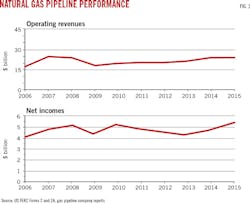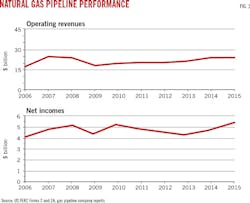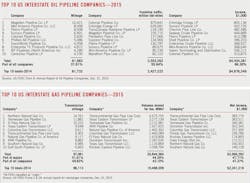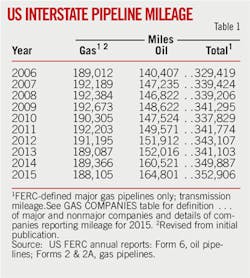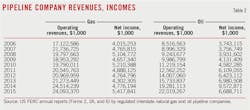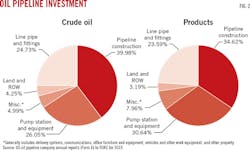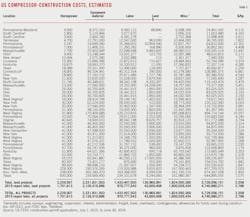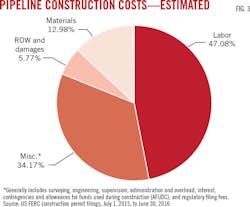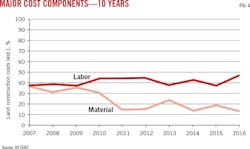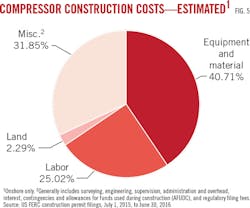Natural gas pipeline profits, construction both up
Christopher E. Smith
Managing Editor, Technology
Natural gas pipeline operators' net income continued to rise despite the first drop in revenues since 2009. Additions to gas pipeline operators' systems also grew, up nearly 46% from 2014. This increase came despite a $2.4-million/mile rise in pipeline construction costs as pressure continued to be felt to bring gas to market.
US oil pipeline operators' net incomes, however, fell more than 30% in 2015 despite revenues increasing for the tenth time in as many years, up more than 14% for 2015. Investment in oil pipeline carrier property also slowed, rising roughly $8.5 billion after climbing about $17 billion the year before.
The bulk of the net income losses came from just two companies-BreitBurn Operating LP losing roughly $2.3 billion on its way to going out of business and TransCanada Keystone Pipeline LP losing about $830 million-the rest of the segment registering a combined year-on-year gain when these companies results are excluded.
Details
The sharp drop in oil pipeline profits as compared with revenues saw earnings as a percent of revenue plunge to 30.38%, by far the lowest level in the past 10 years. Natural gas pipeline operators saw their profits climb more than 13% to roughly $5.4 billion, the highest level seen in the past decade, despite a 1.7% drop in revenues (Fig. 1).
Proposed new-build natural gas mileage was 12.8% higher than 2015's announced build, despite the higher construction costs, while planned horsepower additions jumped more than 42% as compressor construction costs fell.
More expensive labor was the primary driver of higher pipeline construction costs, rates nearly doubling to $3.6 million/mile from $2.0 million/mile. Miscellaneous costs and right of way costs also rose, but not to the extent of labor. The roughly $2.4-million increase in total estimated $/mile land pipeline construction costs brought them to $7.65 million per mile, 46% higher than 2015.
Actual land pipeline construction costs for projects completed in the 12 months ending June 30, 2016, were roughly $400,000/mile more than estimated costs. Higher than expected labor and ROW costs more than made up for lower than estimated materials and miscellaneous charges. Actual compressor station costs were nearly identical to estimated costs for projects completed by June 30, 2016.
US pipeline data
At the end of this article, two large tables offer a variety of data for US oil and gas pipeline companies: revenue, income, volumes transported, miles operated, and investments in physical plants. These data are gathered from annual reports filed with FERC by regulated oil and natural gas pipeline companies for the previous calendar year.
Data is also gathered from periodic filings with FERC by those regulated natural gas pipeline companies seeking FERC approval to expand capacity. OGJ keeps a record of these filings for each 12-month period ending June 30.
Combined, these data allow an analysis of the US regulated interstate pipeline system.
• Annual reports. Companies that, in FERC's determination , are involved in the interstate movement of oil or natural gas for a fee are jurisdictional to FERC, must apply to FERC for approval of transportation rates, and therefore must file a FERC annual report: Form 2 or 2A, respectively, for major or nonmajor natural gas pipelines; Form 6 for oil (crude or product) pipelines.
The distinction between "major" and "nonmajor" is defined by FERC and appears as a note at the end of the table listing all FERC-regulated natural gas pipeline companies for 2015 at the end of this article.
The deadline to file these reports each year is in April. For a variety of reasons, a number of companies miss that deadline and apply for extensions, but eventually file an annual report. That deadline and the numerous delayed filings explain why publication of this OGJ report on pipeline economics occurs later in each year. Earlier publication would exclude many companies' information.
• Periodic reports. When a FERC-regulated natural gas pipeline company wants to modify its system, it must apply for a "certificate of public convenience and necessity." This filing must explain in detail the planned construction, justify it, and-except in certain instances-specify what the company estimates construction will cost.
Not all applications are approved. Not all that are approved are built. But, assuming a company receives its certificate and builds its facilities, it must-again, with some exceptions-report back to FERC how its original cost estimates compared with what it actually spent. OGJ spends the year July 1 to June 30 monitoring these filings, collecting them, and analyzing their numbers.
OGJ's exclusive, annual Pipeline Economics report began tracking volumes of gas transported for a fee by major interstate pipelines for 1987 (OGJ, Nov. 28, 1988, p. 33) as pipelines moved gradually after 1984 from owning the gas they moved to mostly providing transportation services.
Volumes of natural gas sold by pipelines have been steadily declining, so that, beginning with 2001 data in the 2002 report, the table only lists volumes transported for others.
The company tables also reflect asset consolidation and merger activity among companies in their efforts to improve transportation efficiencies and bottom lines.
Reporting changes
The number of companies required to file annual reports with FERC may change from year-to-year, with some companies becoming jurisdictional, others nonjurisdictional, and still others merging or being consolidated out of existence.
Such changes require care be taken in comparing annual US petroleum and natural gas pipeline statistics.
Institution by FERC of the two-tiered (2 and 2A) classification system for natural gas pipeline companies after 1984 further complicated comparisons (OGJ, Nov. 25, 1985, p. 55).
Only major gas pipelines are required to file miles operated in a given year. The other companies may indicate miles operated, but are not specifically required to do so.
For several years after 1984, many non-majors did not describe their systems. But filing descriptions has since become standard, and most provide miles operated.
Reports for 2015 show an increase in FERC-defined major gas pipeline companies: 96 companies of 169 filing, from 93 of 165 for 2014.
The FERC made an additional change to reporting requirements in 1995 for both crude oil and petroleum products pipelines. Exempt from requirements to prepare and file a Form 6 were pipelines with operating revenues at or less than $350,000 for each of the 3 preceding calendar years. These companies must now file only an "Annual Cost of Service Based Analysis Schedule," which provides only total annual cost of service, actual operating revenues, and total throughput in both deliveries and barrel-miles.
In 1996 major natural gas pipeline companies were no longer required to report miles of gathering and storage systems separately from transmission. Thus, total miles operated for gas pipelines consist almost entirely of transmission mileage.
FERC-regulated major natural gas pipeline mileage rose slightly in 2015 (Table 1), final data showing an increase of 3,019 miles, or 0.86%.
Rankings; activity
Natural gas pipeline companies in 2015 saw operating revenues fall nearly $421 million or roughly 1.7% from 2014, reversing the gains seen the past few years. Net incomes, however, continued to grow, climbing nearly $642 million (about 13.4%).
Oil pipeline earnings fell nearly $2.9 billion (roughly 30%) despite a more than $2.7 billion (14.2%) increase in revenues (Table 2). The fall in earnings more than erased the segment's substantial 2014 earnings increase.
Crude deliveries for 2015 increased by nearly 1.6 billion bbl or 17%, while product deliveries rose 402 million bbl (5.8%).
OGJ uses the FERC annual report data to rank the top 10 pipeline companies in three categories (miles operated, trunkline traffic, and operating income) for oil pipeline companies and three categories (miles operated, gas transported for others, and net income) for natural gas pipeline companies.
Positions in these rankings shift year to year, reflecting normal fluctuations in companies' activities and fortunes. But also, because these companies comprise such a large portion of their respective groups, the listings provide snapshots of overall industry trends and events.
For instance, earnings for the Top 10 oil pipeline companies slipped just 5% compared with the 30% overall drop, suggesting-when combined with the concentration of losses in just two companies-that smaller operators fared better than their larger counterparts. The Top 10 companies' share of the segment's total earnings ballooned to almost two-thirds along the way, up from roughly 48% in 2014.
Net income as a portion of natural gas pipeline operating revenues rebounded to 22.49% in 2015, up from 2014's 11-year+ low of 19.48%. The percentage of income as operating revenues for oil pipelines plunged to 30.38% from 2014's record 49.64%.
Net income as a portion of gas-plant investment continued to rise, reaching 3.43% in 2015, up from the previous year's 3.14% and continuing the rebound off the 17-year low of 2.93% in 2013. Net income as a portion of investment in oil pipeline carrier property fell to 7.15%, approaching 1998's level of 6.8% after having reached 11.3% in 2014.
Major and nonmajor natural gas pipelines in 2015 reported total gas-plant investment of roughly $158 billon, the highest level ever, up from $152 billion in 2014, about $147 billion in 2013, more than $142 billion in 2012, $138.6 billion in 2011, $124.7 billion in 2010, almost $121.3 billion in 2009, and nearly $105.8 billion in 2008.
Investment in oil pipeline carrier property continued to surge in 2015 despite the downturn in earnings, surpassing $93 billion, more than double the values seen just 5 years before. Carrier property in 2014 totaled nearly $85 billion after hitting $68 billion in 2013, topping $54 billion in 2012, hitting roughly $49 billion in 2011, more than $45 billion in 2010, roughly $42 billion in 2009, $39 billion in 2008, almost $36 billion in 2007, and beginning its current upward momentum in 2006 to $32.7 billion from the lowest level seen since at least 1997, $29.5 billion in 2005.
OGJ for many years has tracked carrier-property investment by five crude oil pipeline and five products pipeline companies chosen as representative in terms of physical systems and expenditures (Table 3). In 2003, we added the base carrier-property investment to allow for comparisons among the anonymous companies.
The five crude oil pipeline companies in 2015 increased their overall investment in carrier property by nearly $1.8 billion (15.7%), slowing the gains seen in 2014 and 2013 but outpacing the segment as a whole. All of the companies increased investment in carrier property, but more than $1.6 billion of the overall gain came from a single operator.
The five products pipeline companies saw their overall investment in carrier property slow more dramatically in 2015, adding just $211 million, or 2.6%.
Comparisons of data in Table 3 with previous years' must be done with caution as mergers, acquisitions, and sales can make comparisons with previous years' data difficult.
Fig. 2 illustrates how investments in the crude oil and products pipeline companies were divided.
Construction mixed
Applications to FERC by regulated interstate natural gas pipeline companies to modify certain systems must, except in certain instances, provide estimated costs of these modifications in varying degrees of detail.
Tracking the mileage and compression horsepower applied for and the estimated costs can indicate levels of construction activity over 2-4 years. Tables 4 and 5 show companies' estimates during the period July 1, 2015, to June 30, 2016, for what it will cost to construct a pipeline or install new or additional compression.
These tables cover a variety of locations, pipeline sizes, and compressor-horsepower ratings.
Not all projects proposed are approved. And not all projects approved are eventually built.
Application mileage filed in the 12 months ending June 30, 2016, continued the increases started last year.
• Nearly 2,500 miles of pipeline were proposed for land construction, the highest level since more than 2,700 miles were proposed in 1998. No new offshore work was submitted. The land level was up from the 2,192 miles proposed for land construction in 2015 and the 523 miles of pipeline proposed for land construction in 2014.
• New or additional compression proposed by the end of June 2016 measured more than 2.4 million hp, up from the 1.7-million hp proposed the year before and more than triple the then high of roughly 706,000 hp proposed in 2014.
Putting the uptick in US gas pipeline construction in perspective, Table 4 lists 33 land-pipeline "spreads," or mileage segments, compared with:
• 46 land and 0 marine projects (OGJ, Sept. 7, 2015, p. 114).
• 31 land and 0 marine projects (OGJ, Sept. 1, 2014, p. 122).
• 26 land and 2 marine projects (OGJ, Sept. 2, 2013, p. 117).
• 11 land and 0 marine projects (OGJ, Sept. 3, 2012, p. 118).
• 31 land and 0 marine projects (OGJ, Sept. 5, 2011, p. 97).
• 8 land and 0 marine projects (OGJ, Nov. 1, 2010, p. 108).
• 21 land and 0 marine projects (OGJ, Sept. 14, 2009, p. 66).
• 19 land and 0 marine projects (OGJ, Sept. 1, 2008, p. 58)
• 25 land and 1 marine project (OGJ, Sept. 3, 2007, p. 51)
Nine of the spreads in 2016 measured 100 miles or more, as interest in building large transmission lines remained; four of the proposed projects included more than 200 miles of pipe each.
For the 12 months ending June 30, 2016, the 33 land projects would cost an estimated $18.9 billion, as compared with 46 land projects for $11.5 billion a year earlier.
It is helpful to remember that these statistics cover only FERC-regulated pipelines. Many other pipeline construction projects were announced in the 12 months ending June 30, 2016, but may have lied outside FERC's jurisdiction.
A report released in April 2016 on behalf of the Interstate Natural Gas Association of America concluded that the US and Canada will require annual average midstream natural gas, crude oil, and NGL infrastructure investment of $26 billion/year, or $546 billion (in 2015 dollars) total, from 2015 to 2035. Most of this expenditure (roughly 61%) will be dedicated to natural gas development, with crude oil getting roughly 30% and NGL-related assets about 9%.
Included in the $26 billion/year are:
• $7.3 billion/year for new oil and gas lease equipment.
• $6.25 billion/year for expanded gas and liquids mainline capacity.
• More than $3 billion/year for new oil and gas gathering lines.
• Nearly $2 billion/year for new laterals.
• $3.55 billion/year for LNG export plants.
• $1.5 billion/year for gas processing plants.
• $900 million/year for NGL fractionation plants.
• $550 million/year for underground gas storage, crude oil storage, and NGL export terminals.
The report also forecast the need for about 296,000 miles of pipeline 2015-2035, including 23,000 miles of new natural gas transmission lines, 39,000 miles of new pipeline for gas, oil, and NGL transport, and 257,000 of new gas and oil gathering line to collect incremental production from roughly 752,000 new oil and gas wells.1
Against this backdrop, estimated $/mile costs for new projects as filed by operators with FERC remained historically high. For proposed onshore US gas pipeline projects in 2015-16 the average cost was $7.65 million/mile, up from both the 2014-15 average cost of $5.2 million/mile and the 2013-14 average cost of $6.6 million/mile. In 2012-13 the average cost was $4.1 million/mile as compared with $3.1 million/mile in 2011-12; $4.4 million/mile in 2010-11; $5.1 million/mile in 2009-10; and $3.7 million/mile in 2008-09.
Cost components
Variations over time in the four major categories of pipeline construction costs-material, labor, miscellaneous, and right-of-way (ROW)-can also suggest trends within each group.
Materials can include line pipe, pipe coating, and cathodic protection.
"Miscellaneous" costs generally cover surveying, engineering, supervision, contingencies, telecommunications equipment, freight, taxes, allowances for funds used during construction (AFUDC), administration and overheads, and regulatory filing fees.
ROW costs include obtaining rights-of-way and allowing for damages.
For the 33 land spreads filed for in 2015-16, cost-per-mile projections rose in all categories except material. In 2011 miscellaneous charges passed material to become the second most expensive cost category and they retained this position through 2016:
• Material-$992,991/mile, down from $1,012,698/mile 2014-15.
• Labor-$3,603,334/mile, up from $1,977,938/mile for 2014-15.
• Miscellaneous-$2,615,028/mile, up from $1,867,393/mile for 2014-15.
• ROW and damages-$441,548/mile, up from $378,255/mile for 2014-15.
The continued rise in miscellaneous costs is driven by companies increasing the amount set aside for contingencies in their estimates.
Table 4 lists proposed pipelines in order of increasing size (OD) and increasing lengths within each size.
The average cost-per-mile for the projects rarely shows clear-cut trends related to either length or geographic area. In general, however, the cost-per-mile within a given diameter decreases as the number of miles rises.
Lines built nearer populated areas tend to have higher unit costs. Additionally, road, highway, river, or channel crossings and marshy or rocky terrain each strongly affect pipeline construction costs.
Fig. 3, derived from Table 4, shows the major cost-component splits for pipeline construction costs.
Labor spiked as a portion of land construction costs, reinforcing its place as the single most expensive category. Labor's portion of estimated costs for land pipelines jumped to 47.08% in 2016 from 37.77% in 2015, 42.36% in 2014, 38.84% in 2013, 44.61% in 2012, 44.27% in 2011, and 44.61% in 2010. Material costs for land pipelines, meanwhile, eased to 12.98% from 19.34% in 2015, 13.6% in 2014, 23.2% in 2013, 15.99% in 2012, and 14.54% in 2011.
Fig. 4 plots a 10-year comparison of land-construction unit costs for the two major components, material and labor.
Fig. 5 shows the cost split for land compressor stations based on data in Table 5.
Table 6 lists 10 years of unit land-construction costs for natural gas pipeline with diameters ranging from 8 to 36 in. The table's data consist of estimated costs filed under CP dockets with FERC, the same data shown in Tables 4 and 5.
Table 6 shows that the average cost per mile for any given diameter may fluctuate year to year as projects' costs are affected by geographic location, terrain, population density, or other factors.
Completed projects' costs
In most instances, a natural gas pipeline company must file with FERC what it has actually spent on an approved and built project. This filing must occur within 6 months after the pipeline's successful hydrostatic testing or the compressor's being put in service.
Fig. 6 shows 10 years of estimated vs. actual costs on cost-per-mile bases for project totals.
Tables 7 and 8 show actual costs for pipeline and compressor projects reported to FERC during the 12 months ending June 30, 2016. Fig. 7, for the same period, depicts how total actual costs ($/mile) for each category compare with estimated costs. The spike in both categories for 2014 stems from a larger than usual proportion of the pipeline mileage completed that year being in high-cost urban northeast US settings.
Actual labor costs for pipeline construction were more than $500,000/mile higher than estimated costs for the same projects. Overall actual costs were nearly 9% higher than projected costs for the 12 months ending June 30, 2016, despite lower material and miscellaneous costs.
Some of these projects may have been proposed and even approved much earlier than the 1-year survey period. Others may have been filed for, approved, and built during the survey period.
If a project was reported in construction spreads in its initial filing, that's how projects are broken out in Table 4. Completed projects' cost data, however, are typically reported to FERC for an entire filing, usually but not always separating pipeline from compressor-station (or metering site) costs and lumping various diameters together.
The 12 months ending June 30, 2016, saw more than 218,000 hp completed, roughly flat from the year before. Actual compression costs were just $14/hp (0.46%) lower than estimates (Table 8).
References
1. ICF International, "North American Midstream Infrastructure Through 2035; Leaning into the Headwinds," Apr. 12, 2016.
Twice yearly, OGJ compiles an activity report on oil and gas processing facilities and pipelines under construction. Find information about the Worldwide Construction survey here.
About the Author
Christopher E. Smith
Editor in Chief
Chris brings 32 years of experience in a variety of oil and gas industry analysis and reporting roles to his work as Editor-in-Chief, specializing for the last 20 of them in the midstream and transportation sectors.
